
The 1903 Tour de France was the first cycling race set up and sponsored by the newspaper L'Auto, ancestor of the current daily, L'Équipe. It ran from 1 to 19 July in six stages over 2,428 km (1,509 mi), and was won by Maurice Garin.

The mountains classification is a secondary competition in the Tour de France, that started in 1933. It is given to the rider that gains the most points for reaching mountain summits first. The leader of the classification is named the King of the Mountains, and since 1975 wears the polka dot jersey, a white jersey with red polka dots.
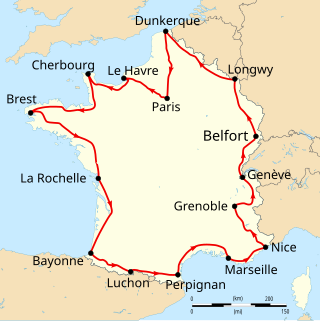
The 1914 Tour de France was the 12th edition of the Tour de France, taking place in 15 stages from 28 June to 26 July. The total distance was 5,380 kilometres (3,340 mi) and the average speed of the riders was 26.835 kilometres per hour (16.674 mph). It was won by the Belgian cyclist Philippe Thys.

The 1906 Tour de France was the fourth edition of the Tour de France, and the second to use the points system. Taking place from 4 to 29 July, the total race distance was 4,637 kilometres (2,881 mi) run over 13 stages, with the winner averaging 24.463 kilometres per hour (15.201 mph). New to this year's edition were the mountain climbs in the Massif Central. However, like its predecessors, cheating and sabotage still took place. Four competitors were disqualified for taking trains as a shortcut and spectators threw nails on the road. However, this did not stop René Pottier from taking a big lead in the first stages. Free of the tendinitis that had plagued his 1905 chances, he dominated the entire race.

The 1907 Tour de France was the fifth running of the annual Tour de France, one of cycling's Grand Tours. From 8 July to 4 August, the 93 cyclists cycled 4488 km (2,788 mi) in fourteen stages around France. The winner, Lucien Petit-Breton, completed the race at an average speed of 28.47 km/h (17.69 mi/h). For the first time, climbs in the Western Alps were included in the Tour de France. The race was dominated at the start by Émile Georget, who won five of the first eight stages. In the ninth stage, he borrowed a bicycle from a befriended rider after his own broke. This was against the rules; initially he received only a small penalty and his main competitors left the race out of protest. Georget's penalty was then increased and Lucien Petit-Breton became the new leader. Petit-Breton won two of the remaining stages and the overall victory of the Tour.
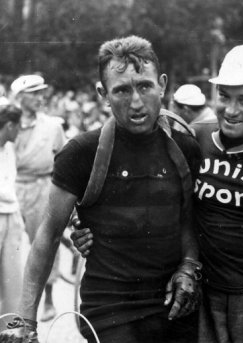
Sylvère Maes was a Belgian cyclist, who is most famous for winning the Tour de France in 1936 and 1939. In 1937, Maes left the 1937 Tour de France together with his Belgian team while he was leading the general classification, in response to actions from French spectators and decisions from the jury.

The 1923 Tour de France was the 17th edition of the Tour de France, taking place 24 June to 22 July. It consisted of 15 stages over 5386 km, ridden at an average speed of 24.233 km/h. The race was won by Henri Pélissier with a convincing half-hour lead to his next opponent, Italian Ottavio Bottecchia. In total, 139 cyclists entered the race, of which 48 finished. Pélissier's victory was the first French victory since 1911, as the Tour de France had been dominated by Belgian cyclists since then.

The 1926 Tour de France was the 20th edition of the Tour de France, taking place from 20 June to 18 July. It consisted of 17 stages with a total distance of 5745 km, ridden at an average speed of 24.064 km/h.

The 1974 Tour de France was the 61st edition of the Tour de France, one of cycling's Grand Tours. It took place between 27 June and 21 July, with 22 stages covering a distance of 4,098 km (2,546 mi). Eddy Merckx was attempting to win his fifth Tour de France in as many races.

The 1908 Tour de France was the sixth running of the annual Tour de France, one of cycling's Grand Tours. It was organised by the newspaper L'Auto, and took place between 13 July and 9 August. The Tour was split in 14 stages, with a total distance of 4,497 kilometres (2,794 mi).

The 1909 Tour de France was the seventh edition of the Tour de France, taking place from 5 July to 1 August. It consisted of 14 stages over 4,497 kilometres (2,794 mi), ridden at an average 28.658 km/h. The results were computed by points accorded finishing positions on each stage, the rider with fewest points at the end of the race winning the race. The stages were approximately the same as in the 1907 and 1908 Tour de France.
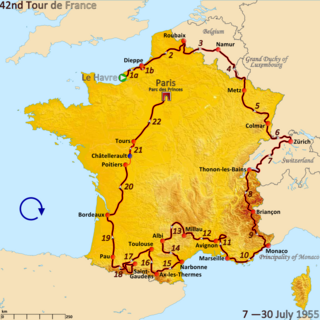
The 1955 Tour de France was the 42nd edition of the Tour de France, taking place from 7 to 30 July. It consisted of 22 stages over 4,495 km (2,793 mi). The race was won by Louison Bobet, the last of his three consecutive wins.
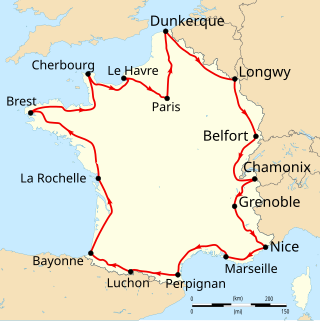
The 1912 Tour de France was the tenth running of the Tour de France. It consisted of 15 stages for a total of 5,289 kilometres (3,286 mi). The Tour took place from 30 June to 28 July. The riders rode at an average speed of 27.763 km/h (17.251 mph). After 4 stage wins during the Tour of Belgium, the Alcyon team hired Odile Defraye to help Gustave Garrigou repeat his win of the 1911 Tour de France. However, as the race progressed, it was clear that Defraye was the stronger rider, and he was made team leader. Defraye won the 1912 Tour de France, while Garrigou came in third place.
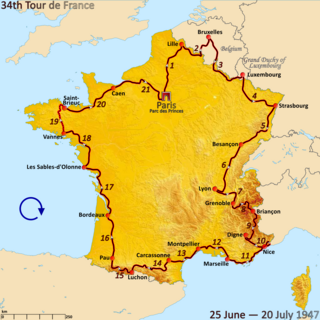
The 1947 Tour de France was the 34th edition of the Tour de France, taking place from 25 June to 20 July. The total race distance was 21 stages over 4,642 km (2,884 mi). It was the first Tour since 1939, having been cancelled during World War II, although some Tour de France-like races had been held during World War II.
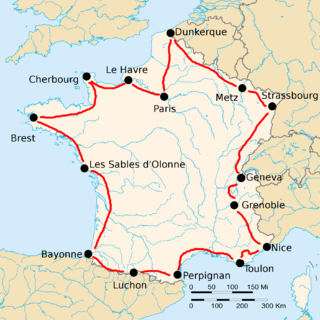
The 1921 Tour de France was the 15th edition of the Tour de France, taking place 26 June to 24 July. The total distance was 5,485 km (3,408 mi) and the average speed of the riders was 24.720 km/h. The race was won by Belgian Leon Scieur. The Belgians dominated the entire race, partly due to the absence of the French Pélissier brothers, who were on bad terms with the Tour organisation. Scieur's victory was largely uncontested; Hector Heusghem came close after the sixth stage, but lost time later. The organisation tried to get the cyclists to attack more by several means, but this failed.

The 1922 Tour de France was the 16th edition of the Tour de France and was held from 25 June to 23 July. The 1922 Tour consisted of 15 stages covering a total of 5,375 kilometres (3,340 mi). The Tour de France was won by the Belgian cyclist Firmin Lambot, who had also won the 1919 Tour de France.

The 1925 Tour de France was the 19th edition of the Tour de France. It was held from 21 June to 19 July, over 5,440 km (3,380 mi) in 18 stages. Italian Ottavio Bottecchia successfully defended his 1924 victory to win his second consecutive Tour. Only 49 of the 130 participants finished the course.

The 1935 Tour de France was the 29th edition of the Tour de France, taking place from 4 to 28 July. It consisted of 21 stages over 4,338 km (2,696 mi). Although the French team was favourite, Belgian Romain Maes took the lead in the first stage, and never gave it away. Halfway the race, Romain Maes' biggest threat, Antonin Magne, had to abandon after he was hit by a motorist.

The 1937 Tour de France was the 31st edition of the Tour de France, taking place from 30 June to 25 July. It consisted of 20 stages with a total length of 4,415 km (2,743 mi).















